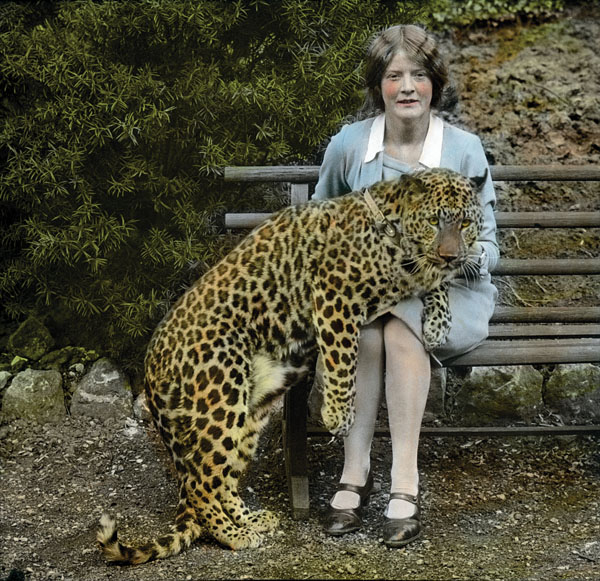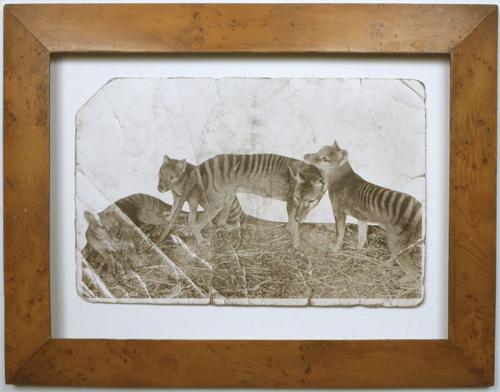
In an Australian state obsessed by the potential of sighting a single Tasmanian Tiger, it seems obscene to lay eyes on a floor rug composed of a grid of eight skins of this animal. In my mind I screamed 'No! How could they?' but those were different times, when those tell-tale stripes weren't on everything from government letterhead to bottles of beer. Fierce or Friendly: Humans in the Animal World is a compelling survey of Tasmanian art and museological collections that explores the complex relationship between humans and other animals. The show is loosely grouped into a series of overlapping themes installed throughout five rooms. The subtitle of the show, Humans in the Animal World, suggests the frame for selection as each of the themes revolve around humanity: hunting, preservation (taxidermy), domestication, anthropomorphism, collection (zoos), entertainment (the circus), and art based on animals.
A room dedicated to the practice of hunting opens the exhibition with a mix of artistic documentation, artefacts and trophies. While there is a dry feel to the room on first glance, closer examination reveals an extraordinary series of works, which, in the most part, glorify the act of animal slaughter. Here, there is no gore or difficult, heaving death but the quality of the imagery is stunning. Two 1897 watercolours by Neville Cayley, Shot Snipe and Shot Duck, are exquisite renditions of the moment of death for each of these beautiful birds. Captured in mid-air, backs arching with the shock of the gunfire, only a splash of blood and a tiny puff of feathers betrays the final act. On the opposite wall, the animals are the hunters in a series of etchings with aquatint by Herbert Dicksee, portraying large carnivorous animals with utter precision and clever composition. In each, the focus of the animal's attention sits outside of the frame, creating a sense of tension. The naming of the works, Play, Suspense, Thirst, Baffled, hints at anthropomorphism. I'm taken by Baffled, a work depicting a pack of wolves pausing mid-hunt, heads together, mouths panting, muzzles sniffing the wind. I can almost hear their breath.
The second room is dedicated to the preservation of animal 'material' in a range of forms. The story begins with the unfortunate Dodo. Considered ugly and inedible by Portugese colonialists in Mauritius, the bird was extinct within 60 years, killed off by new predators including humans, dogs, pigs and rats. The remaining cabinets reveal extraordinary artefacts including fans complete with hummingbirds, a mat made from a platypus, albatross beak coat hooks and a handwarmer of penguin feathers. The crowning installation in this room is a recreation of an arrangement of photographs from the start of the 20th century documenting a donation of stuffed birds to TMAG by Mr H M Courage of Snowdenham Hall, England. Set up in Victorian museological style, with a mass of birds on tiered bases along dark wooden tables and cabinets, the presentation speaks of an era when zoological specimens were killed, captured and stuffed and the expression 'animal preservation' had an entirely different meaning.
Human fascination with big cats dominates room three. Preserved by taxidermy, two leopards, and a Sumatran tiger are caught mid-stride in the centre of the room. Leading the pack, the tiger's jaws are open, teeth bared. It is the part of the show that kids are excited by, arguing about what type of cat they are and surreptitiously touching their fur. While I'm sure this fascination relates to their sleek beauty, there must also be morbid interest in these cats being some of the few animals still threatening human life. Surrounding these cats are a series of paintings and photographs depicting various ways of 'seeing', capturing and containing these animals. Paintings by William Strutt and Herbert Dicksee depict different aspects of the big cats. Strutt's painting, Sentinels of the Empire: the British lion and his sturdy cubs (1901) is a strangely twee image of a Pride of Lions on a flower-strewn hillside. The strength, grace and familial closeness of the group of Lions were intended to reflect the power and unity of the British Empire. More sympathetic to the beasts, Stealth (1914), by Herbert Dicksee, shows a leopard mid-hunt, stalking around a rocky outcrop, every muscle in tension. I love a hand-coloured photograph by JW Beattie, depicting Alison Reid, daughter to Beaumaris Zoo owners, with her pet leopard. The accompanying text describes an extraordinary vision of her regular walks with the leopard on the Queen's Domain (parkland adjacent to the zoo), where she sometimes let the lead run a little longer if strange men approached!
Room four depicts the raft of animals domesticated by humans for work, food or companionship. As the text for this collection describes, most animals can be tamed in some form, but domestication occurs gradually over thousands of years and relies on these creatures being '...safe to have around.' This section sits in contrast to the previous rooms. The 'usefulness' of the domesticated animal has transformed its treatment by humans and its subsequent depiction in art and artefact. It is not hunted, its health is actively maintained, it might sleep with us like family and will only be stuffed as an emotional artefact. It is almost as though domestication renders animals more human. In the Western world we find it abhorrent to consider eating horse, dog or cat meat and I wonder what feelings a floor rug made from eight Labrador skins might arouse in museum visitors.
The final room in this exhibition is dedicated to work by contemporary artists. This selection is a disappointingly tiny survey of modern works and as such can only lightly touch on different aspects of our relation to animals. Barbie Kjar presents the lizard as a mythological alter ego in her etching a woman and a lizard (1996), where the lines of the animal become those of the human. Three gaudy screenprints from the collective The Kingpins (Técha Noble, Emma Price, Katie Price, Angelica Mesiti) present humans intertwined with animals used as symbols, such as snakes. Well-known for her strong views on animal cruelty, Yvette Watt illustrates direct connections between animals and humans through her Making Faces series from 2004, paintings in which she depicts herself with expressions mimicking animals, and two untitled photographs from 2007 in which her eyes are obscured by the eyes of another animal in an obvious, but nonetheless disturbing collage. Watt's joke here is that we are encouraged to find animal characteristics in the human. By doing so, might we respect the animal more?
So, what is this exhibition? Is it a catalogue of failure? An illustration of power and betrayal? Or an intricate story of love? While seeming a little dry in format on first impression, the exhibition unfolds as you wander, quietly building emotions and facts about a multifaceted relationship and questioning human behaviour towards other animals. Our potential to have power over these creatures is what creates the story and its tension in this show. We fear the big cats, but we can put them in cages and use them for our entertainment. We hunt our predators and use guns to slaughter them, before they slaughter us. We can convince a dog to beg for food. I sense that this is a show that brewed in the minds of the curatorial group long before the show opened and I feel as though I imbibed a little of their passion via the reactions it evoked in me, fascination, horror, disgust, amazement, guilt, sadness.












